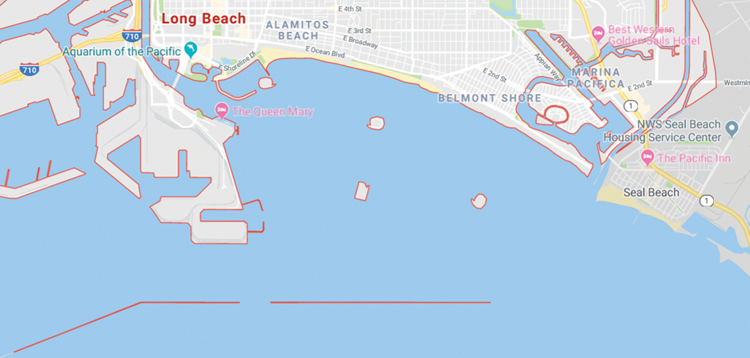The United States Navy has serious concerns about the City of Long Beach’s East San Pedro Bay Ecosystem Restoration Study, an ongoing endeavor by the city and U.S. Army Corps of Engineers assessing multiple “alternatives” to the current configuration of the Long Beach breakwater.
In a letter dated October 2, 2018, obtained last week by the Business Journal, N. J. Dahlke, Captain, U.S. Navy, Commanding Officer, Naval Weapons Station in Seal Beach, informed the city that, “Any modification to the breakwater would bring on increases in wave energy affecting vessel motion and increasing the risk to safety of personnel and damage to vessels and equipment. This unwanted effect would severely impact the Navy’s ability to respond during a time of national or international crisis.”
In the waters behind the structure, an area referred to by the Navy as the “D8 anchorage,” the Navy conducts weapons and munitions transfers between vessels on the water, the letter explained. Any change to the breakwater could result in changes to wave energy, and even “small swells can generate sudden and random shifts in distance and height” between such vessels.
There is no other area within the San Pedro Bay that would meet the Department of Defense’s requirements for the explosives operations the Navy currently conducts, according to Dahlke’s correspondence. He referred to the D8 anchorage as “a unique national asset, strategically located to support Pacific Fleet homeport locations and ordnance supply points, in the event of regional conflicts or other international crisis scenarios.”
The Navy has veto authority over any changes to the breakwater, according to Diana Tang, government affairs manager for the City of Long Beach. But Gregg Smith, public affairs officer for the weapons station, told the Business Journal the Navy was not aware that it has veto authority and that, while he cannot speak for the Army Corps of Engineers, it is up to them to make the final decision.
Asked to clarify the matter, Dena O’Dell, deputy chief of public affairs for the Los Angeles District, U.S. Army Corps of Engineers, wrote in a statement to the Business Journal, “As part of our plan development and selection, we will attempt to identify and analyze beneficial and adverse impacts of alternative plans before we select a plan to recommend for authorization. The Navy’s letter, together with other input, will be important in our decision-making process.”
Tang said the Navy has been informed of the study’s progress since it began at the direction of the city council in 2013. Smith noted that Navy personnel have been engaged in regular contact with the city regarding breakwater modification discussions since at least 2008, when the Navy issued its first letter to the city expressing concerns about potential changes to the breakwater.
Tang clarified that the city and Army Corps of Engineers are still studying potential breakwater reconfigurations, rather than developing specific project recommendations, and noted that Captain Dahlke’s letter was written “before meaningful mitigation measures were developed for consideration.” Proposals for mitigation measures have not yet been released.
It is unclear when the study will be complete. The city council has authorized $2.25 million to fund the study, which is also receiving funding from the Army Corps of Engineers.
“The City of Long Beach collected feedback related to Port Navigation relative to the Draft Alternatives and wave modeling between Sept. 24, 2018, through Oct. 15, 2018,” O’Dell wrote in an e-mail. “The Navy’s letter was received in response to that request. The City of Long Beach shared all input they received with the Corps, and we are considering all comments in our evaluation of the proposed ecosystem restoration alternatives.”
Tang said letters and correspondence in response to the study are not individually released to the public or to the city council, but are collected to inform the study’s progress.
To view the full letter from Captain Dahlke, visit bit.ly/2HZiQqo.

